The MSI Titan GT77 Review: Desktop-Class Core i9-12900HX Tested
by Brett Howse on September 1, 2022 10:00 AM EST- Posted in
- Laptops
- Intel
- MSI
- Alder Lake
- Alder Lake-HX
Platform Power and Multitasking
With Intel’s Alder Lake platform being a hybrid design, it promises better multitasking performance thanks to the inclusion of the many E-Cores on top of the 8 P-Cores already present. The E-cores offer Skylake-like performance in a small, dense design (4 E-cores fit in the space of 1 P-core), allowing Intel to pack in 8 of them while still keeping die sizes (and manufacturing costs) reasonable.
With the MSI Titan GT77 and Intel’s new HX series of processors, multitasking is a key selling feature. Adding an additional two P-Cores increases the ability to perform multiple tasks – particularly those that aren't quite embarrassingly parallel and would do best with more P-cores – while the higher power levels allow the cores to run at a higher frequency to get the work done quicker.
An over seven pound laptop is really all about performance first, and in order to achieve performance you also need adequate cooling or the CPU will throttle itself due to its significant heat output. MSI’s Titan GT77 has an impressive cooling solution which is rated for up to 250 Watts of heat dissipation. Depending on workload, that will be up to 175 Watts for the RTX graphics, and an additional 75 Watts for the processor sustained. But thanks to dynamic boost, if the GPU is not using all of its headroom the CPU can use that extra power.
As is typical of MSI they offer three user-selectable power modes, as well as a Smart AI mode which will automatically change the mode. Extreme Performance offers the highest power draw, and comes with the highest noise levels. Balanced drops the power a bit to keep noise levels in check, and the Silent Mode means that the fans will be inaudible.
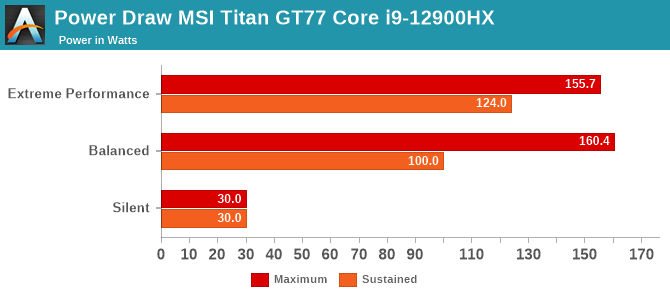
In Extreme Performance mode there is almost a ridiculous amount of power available to the processor. The PL2 maximum is right at the 157 Watt maximum Intel allows for the HX processor, but the PL1 sustained level is a staggering 124 Watts. For a notebook computer, that is really unheard of. What is very impressive though is that despite this power draw, at load in Extreme Performance mode the sound pressure level (SPL) measured one inch over the trackpad never exceeded 58.3 dB(A). That is loud, but if you need the maximum out of the system the four-fan cooling solution can get the job done but it needs to work at it.
Turning things down a bit to the balanced mode means that you get the same PL2 level of 157 Watts (we actually measured just over 160 Watts) but the PL1 level is a more mundane 100 Watts. For comparison, the MSI Raider GE76 with a Core i9-12900HK processor in balanced mode peaks at 105 Watts and runs sustained at 75 Watts. The sustained level in balanced mode here is pretty much the same as the peak on the Raider GE76. That’s a lot of power. This is the selling point of the HX processor. In balanced mode, the SPL was a much more reasonable 52.3 dB(A) which is still noisy but much more reasonable than Extreme Performance.
MSI also offers a Silent mode which caps the processor at just 30 Watts for both PL1 and PL2. Noise is minimized, but at those power levels performance takes a big hit too. In balanced mode the fans don’t make a lot of noise unless you are really working the system, so unless you absolutely can’t have any fan noise, this mode should be avoided.
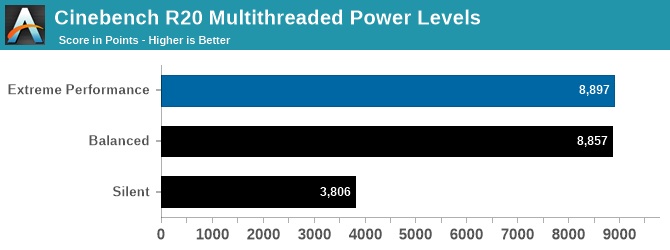
To see how the different power settings impact system performance, Cinebench R20 was run in all three modes. Although this is not a very long test on such a powerful system, it does reinforce that when it comes to CPU performance, the last few percentage points of performance come at the highest cost. Despite the Extreme Performance mode having a 24% higher power level, in Cinebench that only equates to a 0.45% performance increase. If your workload was a longer workload it would likely be higher than that, but thanks to power being an exponential equation it will never be a one to one gain.
The Silent results are very low thanks to the 30 Watt cap resulting in a result that is 57% lower than the Balanced Mode, albeit at 70% lower sustained power.
Multitasking
Replicating the multitasking workloads from the Alder Lake H review, again we will test out how the MSI Titan GT77 handles running multiple workloads at the same time. To give an analytical look at the multitasking abilities of several laptops, a test was created to simulate a workload where an intensive task was shuffled to the background, and then several apps were run in the foreground and the performance measured. To achieve this, Handbrake was set to transcode a long 1080p video to 720p using the x264 software encoder. Then, that task was shuffled to the background, and both PCMark 10’s Modern Office test suite was run, as well as Cinebench R20. Performance was measured for PCMark 10, Cinebench, and Handbrake to get a feel for how the system was handling the intense load.
The results are not so much about the absolute values but what the percentage change was compared to an unloaded result. Let’s dive in.
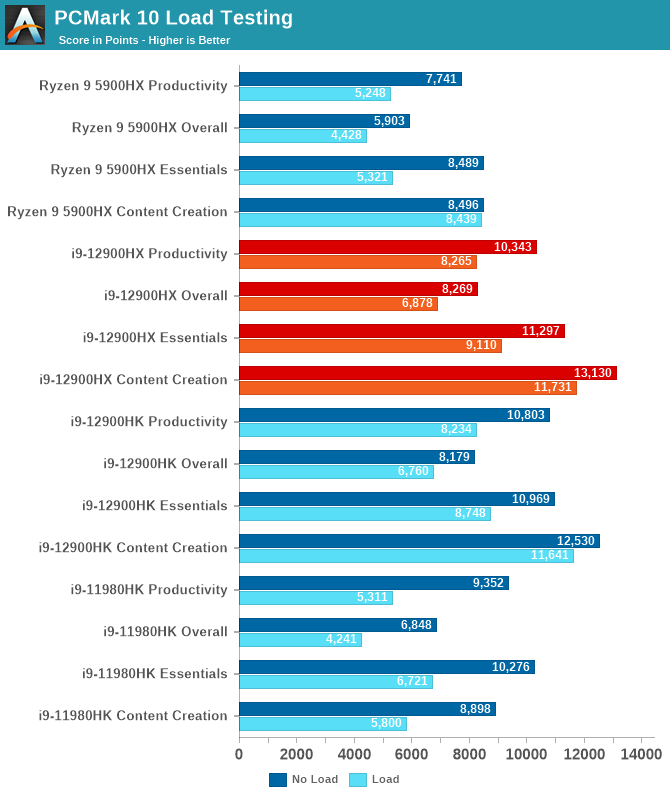
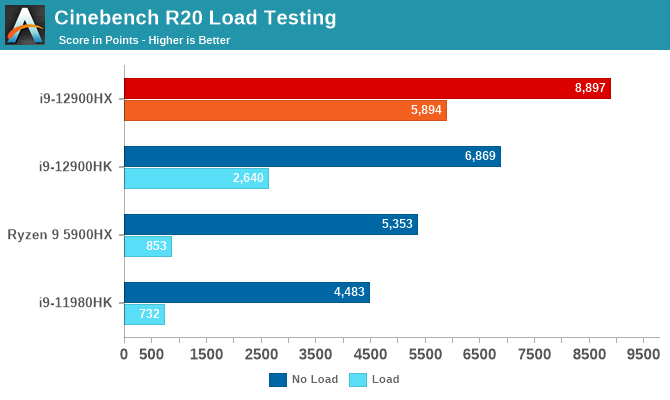
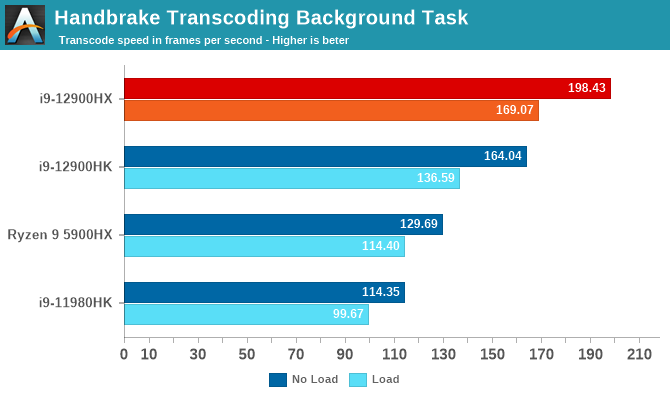
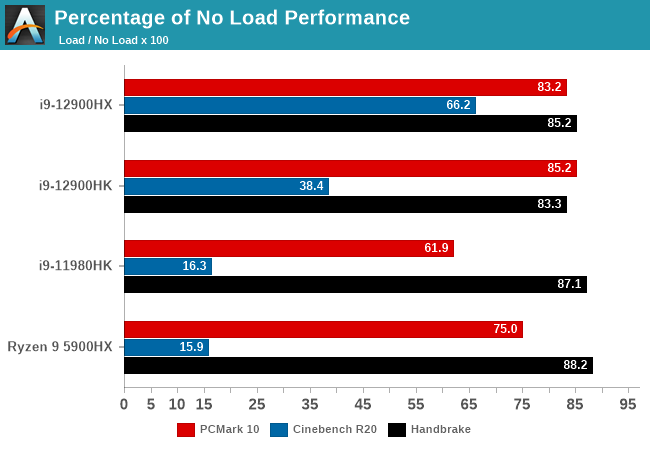
Although the actual scores are included as well for reference, the key graph is Percentage of No Load Performance. On the PCMark 10 result, the i9-12900HX was able to achieve 83.2% of the no-load result with handbrake running a software transcode in the background. That is right in-line with the other Alder Lake processor. It is a significant increase over Tiger Lake (Core i9-11980HK) and Ryzen 5000 (Ryzen 9 5900HX).
The most impressive change was Cinebench R20 though. The new HX processor was able to achieve 66.2% of the no-load result which is significantly higher than the HK CPU. As this was running in Extreme Performance mode, the extra headroom in PL1 as well as the additional two P-Cores definitely helped out here.
The background task for the HX processor, which was Handbrake doing a 1080p to 720p transcode, was again in-line with the HK processor. Both of the Alder Lake processors were unable to achieve as high of a percentage here compared to Tiger Lake and Ryzen, but both show they offer far more foreground performance at the same time. It is an impressive result.
The big win is usability. With Alder Lake, even with a heavy workload running in the background, the system stays responsive and lets you continue working. Looking at absolute performance is also impressive. The HX system was faster doing the Handbrake transcode while loaded than the HK system was able to attain unloaded. There is just a lot of performance on-tap here and it really opens the MSI Titan GT77 up to even more workloads.












25 Comments
View All Comments
IBM760XL - Friday, September 2, 2022 - link
This is how I know my 2018 MSI has poor battery life: a hulking DTR like this has twice the battery life, and my laptop has never had much more battery life than it does now.Props to MSI for finally putting a properly-sized battery in their laptop. But I'm also rather impressed that it can get over 6 hours of battery life in general. The rest of the specs are a bit overkill for what I need, but hopefully they've stopped putting 42 WHr batteries in their dGPU laptops in general. Or at least propagated their recent power efficiency improvements.
Now where's the all-AMD variant that gets battery life figures similar to that Asus? I want the Asus's hardware with the MSI's design.
garblah - Friday, September 2, 2022 - link
Why aren't 120hz OLED or 144hz OLED displays more common on high end gaming laptops? Who is hitting 240hz or 360! hz on a laptop. I can't imagine paying 3000 dollars for a screen with the ubiquitous grey "blacks" of an IPS panel.iranterres - Sunday, September 4, 2022 - link
I gotta love this new batch of stoves that Intel's put to market LOL.Oxford Guy - Monday, September 5, 2022 - link
Titanic tinnitus.snowdrop - Wednesday, September 7, 2022 - link
The multitasking testing only really shows that more threads (& more power) = better at multitasking which seems a bit obvious.The 12900HX is 24 threads (8P, 8E), the 12900HK is 20 threads (6P, 8E), and the 11980HK / 5900HX are both 16 threads so it's hard to discern architectural advantages from Alder Lake.
Adding a 12th gen part with a similar core count to the 11980HK / 5900HX like the 12600H (4P, 8E) or 12650H (6P, 4E) with 16 threads would make this comparison much more useful? Or possibly adding a test of the 12900HK limited to 16 threads by disabling the E cores (8P, 0E)?